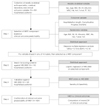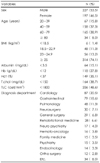Abstract
Malnutrition of hospitalized patients can adversely affect clinical outcomes and cost. Several nutritional screening tools have been developed to identify patients with malnutrition risk. However, many of those possess practical pitfalls of requiring much time and labor to administer and may not be highly applicable to a Korean population. This study sought to develop and evaluate a Nutrition Risk Screening Tool (NRST) which is simple and quick to administer and widely applicable to Korean hospitalized patients with various diseases. The study was also designed to generate a screening tool predictable of various clinical outcomes and to validate it against the Nutritional Risk Screening 2002 (NRS 2002). Electronic medical records of 424 patients hospitalized at a general hospital in Seoul during a 14-month period were abstracted for anthropometric, medical, biochemical, and clinical outcome variables. The study employed a 4-step process consisting of selecting NRST components, searching a scoring scheme, validating against a reference tool, and confirming clinical outcome predictability. NRST components were selected by stepwise multiple regression analysis of each clinical outcome (i.e., hospitalization period, complication, disease progress, and death) on several readily available patient characteristics. Age and serum levels of albumin, hematocrit (Hct), and total lymphocyte count (TLC) remained in the last model for any of 4 dependent variables were decided as NRST components. Odds ratios of malnutrition risk based on NRS 2002 according to levels of the selected components were utilized to frame a scoring scheme of NRST. A NRST score higher than 3.5 was set as a cut-off score for malnutrition risk based on sensitivity and specificity levels against NRS 2002. Lastly differences in clinical outcomes by patients' NRST results were examined. The results showed that the NRST can significantly predict the in-hospital clinical outcomes. It is concluded that the NRST can be useful to simply and quickly screen patients at high-nutritional risk in relation to prospective clinical outcomes.
Figures and Tables
References
1. McWhirter JP, Pennington CR. Incidence and recognition of malnutrition in hospital. BMJ. 1994. 380:945–958.

3. Chima CS, Barco K, Dewitt ML, Maeda M, Teran JC, Mullen KD. Relationship of nutritional status to length of stay, hospital costs, and discharge status of patients hospitalized in the medicine service. J Am Diet Assoc. 1997. 97(9):975–978.

4. Reinhardt GF, Myscofski JW, Wilkens DB, Dobrin PB, Mangan JE Jr, Stannard RT. Incidence and mortality of hypoalbuminemic patients in hospitalized veterans. JPEN. 1980. 4(4):357–359.

5. Robinson G, Goldstein M, Levine GM. Impact of nutritional status on DRG length of stay. JPEN. 1987. 11(1):49–51.

6. Correia MI, Waitzberg DL. The impact of malnutrition on morbidity, mortality, length of hospital stay and costs evaluated through a multivariate model analysis. Clin Nutr. 2003. 22(3):235–239.

7. Kyle UG, Kossovsky MP, Karsegard VL, Pichard C. Comparison of tools for nutritional assessment and screening at hospital admission: a population study. Clin Nutr. 2006. 25(3):409–417.

8. Ruiz-Lopez MD, Artacho R, Oliva P, Moreno-Torres R, Bolanos J, de Teresa C, Lopez MC. Nutritional risk in institutionalized older women determined by the Mini Nutritional Assessment test: What are the main factors? Nutrition. 2003. 19(9):767–771.

9. Bauer J, Capra S, Ferguson M. Use of the scored Patient-Generated Subjective Global Assessment (PG-SGA) as a nutrition assessment tool in patients with cancer. Eur J Clin Nutr. 2002. 56(8):779–785.

10. Kondrup J, Rasmussen HH Hamberg O, Stanga Z. Ad Hoc ESPEN Working Group. Nutritional risk screening (NRS 2002): a new method based on an analysis of controlled clinical trials. Clin Nutr. 2003. 22(3):321–336.

11. Calle EE, Thun MJ, Petrelli JM, Rodriguez C, Health CW Jr. Body-mass index and mortality in a prospective cohort of U.S. adults. N Engl J Med. 1999. 341(15):1079–1105.

12. Corti MC, Guralnik JM, Salive ME, Srkin JD. Disability as predictors of mortality in order persons. JAMA. 1994. 272(13):1036–1042.

13. Akpele L, Bailey JL. Nutrition counseling impacts serum albumin level. J Ren Nutr. 2004. 14(3):143–148.
14. Dzieniszewski J, Jarosz M, Szczygiel B, Dlugosz J, Marlicz K, Linke K, Lachowicz A, Ryzko-Skiba M, Orzeszko M. Nutritional status of patients hospitalized in Poland. Eur J Clin Nutr. 2005. 59(4):552–556.

15. Delgado-Rodriguez M, Medina-Cuadros M, Gomez-Ortega A, Martinez-Galleo G, Mariscal-Ortiz M, Martinez-Gonzalez MA, Sillero-Arenas M. Cholesterol and serum albumin levels as predictors of cross infection, death, and length of hospital stay. Arch Surg. 2002. 137(7):805–812.

16. Ferquson M, Capra S, Bauer J, Banks M. Development of a valid and reliable malnutrition screening tool for adult acute hospital patients. Nutrition. 1999. 15(6):458–464.

17. Messner RL, Stephens N, Wheeler WE, Hawes MC. Effect of admission nutritional status on length of hospital stay. Gastroenterol Nurs. 1991. 13(2):202–205.

18. Wunderlich SM, Tobias A. Relationship between nutritional status indicators and length of hospital stay for patients with diverticular disease. J Am Diet Assoc. 1992. 92(4):429–433.

19. Robinson G, Goldstein M, Levine GM. Impact of nutritional status on DRG length of stay. JPEN. 1987. 11(1):49–51.

20. Reilly JJ Jr, Hull SF, Albert N, Waller A, Bringardener S. Economic impact of malnutrition: a model system for hospitalized patients. JPEN. 1988. 12(4):371–376.

21. Cederholm T, Jaqren C, Hellstrom K. Outcome of protein-energy malnutrition in elderly medical patients. Am J Med. 1995. 98(1):67–74.

22. Velanovich V. The value of routine preoperative laboratory testing in predicting postoperative complication: a multivariate analysis. Surgery. 1991. 109(3 pt 1):236–243.
23. Izawa S, Kuzuya M, Okada K, Enoki H, Koike T, Kanda S, Iguchi A. The nutritional status of frail elderly with care needs according to the mini-nutritional assessment. Clin Nutr. 2006. 25:962–967.

24. Ottery FD. Rethinking nutritional support of the cancer patient: the new field of nutritional oncology. Semin Oncol. 1994. 21(6):770–778.
25. Sunqurtekin H, Sunqurtekin U, Hanci V, Erdem E. Comparison of two nutrition assessment techniques in hospitalized patients. Nutrition. 2004. 20(5):428–432.

26. Reilly HM, Martineau JK, Moran A, Kennedy H. Nutritional screening Evaluation and implementation of a simple Nutrition Risk Score. Clin Nutr. 1995. 14(5):269–273.

27. Kruizenga HM, Seidell JC, de Vet HC, Wierdsma NJ, van Bokhorst-de van der Schueren MA. Development and validation of a hospital screening tool for malnutrition: the short nutritional assessment questionnaire (SNAQ). Clin Nutr. 2005. 24(1):75–82.

28. Vellas B, Guiqoz Y, Garry PJ, Nourhashemi F, Bennahum D, Lauque S, Albarede JL. The mini nutritional assessment (MNA) and its use in grading nutritional state of elderly patients. Nutrition. 1999. 15(2):116–122.

29. Kim SA, Kim SY, Sohn CM. Development of Nutrition Screening Index for Hospitalized Patients. Korean J Community Nutrition. 2006. 11(6):779–784.




 PDF
PDF ePub
ePub Citation
Citation Print
Print










 XML Download
XML Download